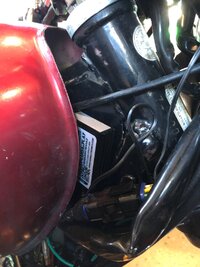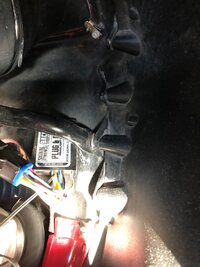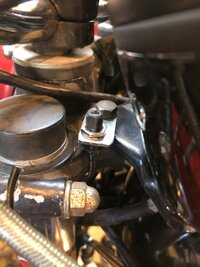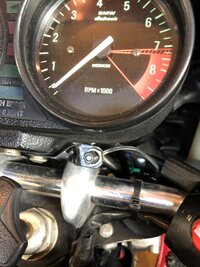No - there are no wires to be cut at all. It is entirely a
plug'n-play deal.
Basically, you buy the standard modulator "box" which has a proprietary 6-pin connector on a short pigtail and then you select the correct custom "bike" harness for your bike's headlight configuration and plug that harness into the pigtail (the website has a good photo of this - and it is very intuitive when you see it). Then you simply thread the two branches of the custom "bike" harness into the bucket. Each branch of the "bike" harness has a regular-sized headlight connector on it (one "male" and one "female"), so you do wind up with one extra headlight connector inside the already pretty full XS650 headlight bucket.
There are several different custom "bike" harnesses available from Signal Dynamics - but my bikes all use the simplest s
ingle H4 halogen harness. When I had the 2007 Honda ST1300 - which had
two H4 headlights - I simply bought the
twin H4 harness. The company website has a whole chart of harnesses and bikes to permit you to buy the correct one for most modern bikes - but the single H4 generic harness is almost certainly what most of us would use for a simple old bike like an XS650 or mid-80s BMW.
Anyhow, after mounting the module somewhere near the front of the bike (see the photos below) you unplug the headlight inside the bucket and insert the "male" version of the normal three-prong headlight connector that is mounted on one branch of the "bike" harness. This "male" connector plugs into the "female" headlight connector on the stock bike wiring harness and the "bike" harness goes back to the proprietary Signal Dynamics 6-pin connector near the modulator "box" (
which is located outside of the headlight bucket). The other branch of the "bike" harness, which has the usual "female" headlight connector, plugs onto the backside of the headlight as usual.
Below are a photo of the modulator box mounted on the '78 XS650E
Betty and another photo of the box mounted inside the fairing on the '83 BMW R100RS
Gretel. The blue thingy in each photo is the proprietary 6-pin connector to which the "bike" harness is connected. I will do a better job of hiding the little modulator box in the spring (likely I'll just put a strip of electrical tape over the labels).
Yamaha XS650E mount >
View attachment 208562 BMW R100RS mount >
View attachment 208564
You also need to mount the little photo-cell / light sensor that defeats the modulator when it is dark outside. I just made a little bracket out of sheet metal and mounted it to the handlebar mount on each bike. Here are photos of the sensors on each of the above bikes:
XS650E light sensor >
View attachment 208565 BMW R100RS light sensor >
View attachment 208566
It may all sound complex - but it couldn't be simpler when you see it - although, as noted, getting the extra headlight connector inside the "t
oo danged small" XS650 headlight bucket took a bit of body English and some use of the
"extended vocabulary".
...and to answer Marty's question about filament life: I have had modulators on my bikes for years and have not had to replace a single headlight bulb on any of them. I put more than 45,000 km (about 25,000 miles) on the ST1300 and both headlights worked fine throughout and even on the XS650 - no replacement bulbs have been required.
On the matter of LED lights - I don't presently have any LED headlights on my bikes - but I have heard that the Signal Dynamics headlight modulator that I am running does not work with LEDs.
There are other modulators that are for use with LEDs however, so you'd need to search for one of those.
Pete




